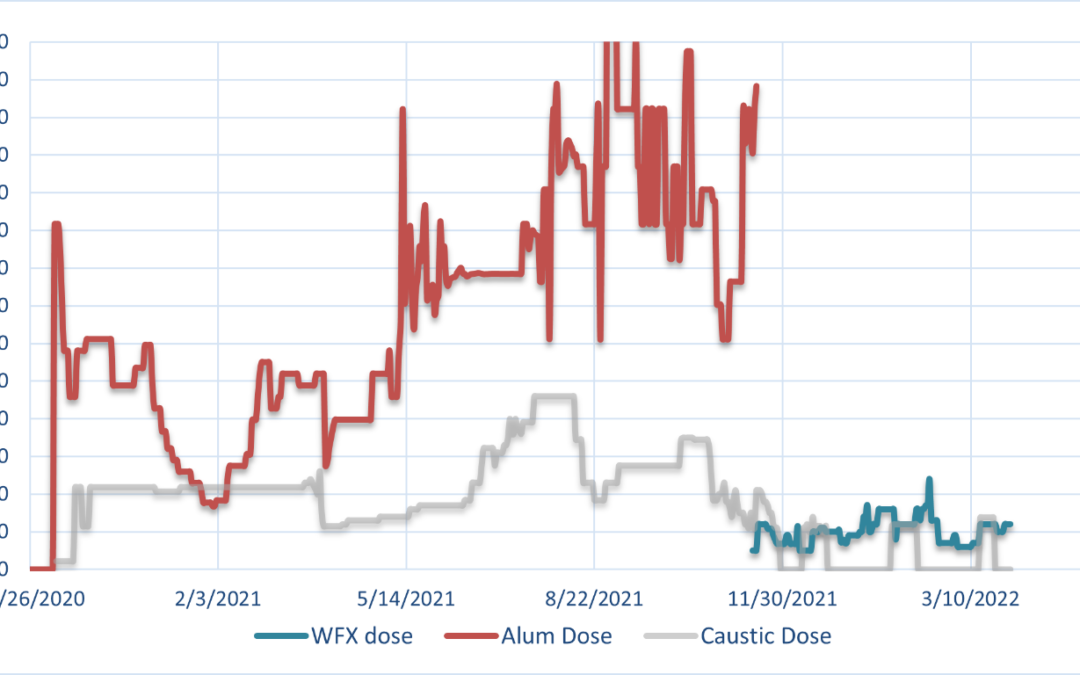With the renewal of their Utah Pollutant Discharge Elimination System (UPDES) permit, Jordanelle Special Service District (JSSD) was confronting extremely low total phosphorus (TP) limits of 0.03 mg/L (May – Oct) and 0.06 mg/L (Nov – April) as a 90-day average at their Jordanelle Water Reclamation Facility (WRF). These limits would take effect 2 years from the start-up of their new Membrane Bioreactor WRF. To achieve this level of phosphorus removal from the wastewater, they initially turned to the conventional but highly acidic coagulant, alum.
Conventional coagulants disrupt the pH balance, destabilizing treatment.
The problem with conventional coagulants like alum is two-fold. First, it is highly acidic, with a pH values of close to 2. Second, it reacts with many compounds, not just phosphorus. The effective dosage can be 4:1 coagulant to P for a moderate limit of 1 mg/L. But as the limit for TP goes down, that ratio can go up exponentially to as high as 10:1 or even higher. So for very low limits, like those at JSSD, the amount of alum added, and with it, acidity, goes up as well. This rapidly consumes all the natural alkalinity in the wastewater, alkalinity that biomass needs to do their work of BOD and ammonia removal.
Neo WaterFX provides superior P removal, with predictable results and far less acidity, stabilizing operations.
Neo WaterFX is a lanthanide-based coagulant that has two major advantages over alum when it comes to pH balance. First, the pH is higher at 3 to 4. While this may not seem like a huge difference, remember that pH is a logarithmic scale, so a difference of 1 pH unit represents 10 times less acidity, and a difference of 2 pH units is 100 times less acidic. But the major difference comes in the chemistry. WaterFX preferentially binds with phosphorus, so that the feed rate is almost a 1:1 ratio of coagulant to P, allowing for a much lower dose even at very low limits. Combine the lower dosage with the lower acidity, and WaterFX will consume 100 to even 1000 times less of your wastewater’s natural alkalinity. Preserving this alkalinity allows the pH in your bioreactor to remain closer to neutral, a better range for both BOD and ammonia removal. The biomass is able to do its job often without adding caustic.
Treatment stability; reduced or eliminated caustic feeds; predictable, reliable P removal.
JSSD began their P control using alum but had difficulty meeting even the winter limits. Feeding extremely high doses failed to meet the summer limits. After a year of struggling and failing to consistently meet the stringent P limit using Alum, and with final limits soon to become effective, JSSD pilot tested WaterFX.
The WaterFX pilot began in November 2021, and with just a few adjustments, JSSD was achieving the winter limit of 0.06 mg/L. The need for caustic fell to zero most days, with only minor adjustments from time to time. The alkalinity of the treatment system was preserved, and treatment was stable and predictable.
After the pilot study ended, minor adjustments in the dosage in May allowed them to achieve their summer limit of 0.03 mg/L consistently. WaterFX’s stability and predictability allow them to maintain compliance without the constant monitoring and adjusting, but most importantly, without the upsets and exceedances that plagued their alum experiment. You can get the details in the Jordanelle Case Study.
Tired of the instability of balancing pH with your phosphorus removal?
If you are faced with low TP limits and are struggling to balance your pH and meet your phosphorus limits, you owe it to your utility to give us a call. Our engineers will assess your operation and develop a plan to both meet your P removal requirements and stabilize your operation. P removal with WaterFX has many other benefits besides pH control and predictable, stable compliance with permit limits. In almost all cases WaterFX is the most cost-effective alternative for your overall operation. Ready to test drive it with a pilot study or want to learn more? Contact us.



